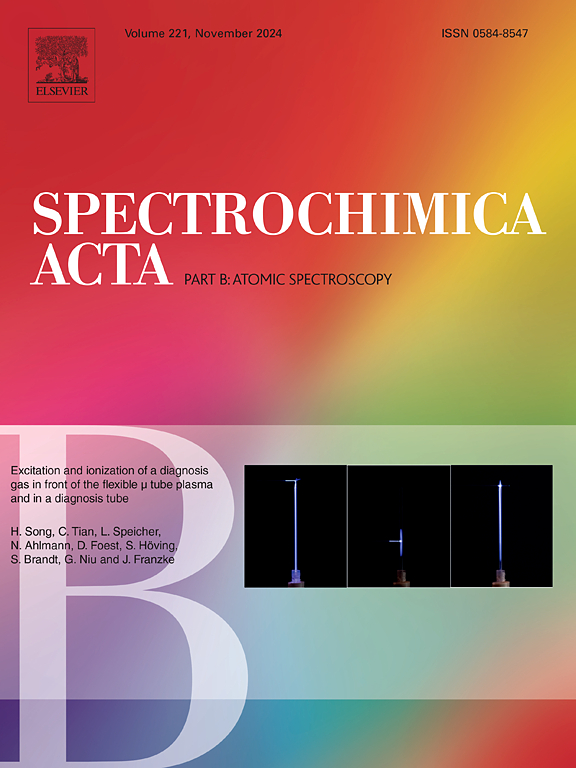How to address self-absorption in LIBS using millisecond time-width detectors
IF 3.8
2区 化学
Q1 SPECTROSCOPY
引用次数: 0
Abstract
To calculate self-absorption in Laser Induced Breakdown Spectroscopy (LIBS) using long-acquisition-time detectors (millisecond-range) it is necessary to account for the evolution of the plasma during the acquisition time and, consequently, the variation in the emitted spectral intensity. This study develops a model that accounts for temperature variations during the measurement period, assuming an adiabatic plasma explosion. By parameterizing all emission and absorption quantities using temperature (T), the model allows for the calculation of spectral line intensities in the presence of self-absorption. The model is applied to binary Ti![]() Zr alloys, where predictions of pure element spectra are compared with experimental data, and self-absorption is analyzed as stoichiometry varies in six alloys. The model's predictions are validated against experimental curve of growth (C.O.G.) values. Furthermore, this approach provides a method to estimate photon emission probabilities (Einstein coefficients, Aki).
Zr alloys, where predictions of pure element spectra are compared with experimental data, and self-absorption is analyzed as stoichiometry varies in six alloys. The model's predictions are validated against experimental curve of growth (C.O.G.) values. Furthermore, this approach provides a method to estimate photon emission probabilities (Einstein coefficients, Aki).

如何解决自吸收在LIBS使用毫秒时宽探测器
为了计算激光诱导击穿光谱(LIBS)中使用长采集时间探测器(毫秒范围)的自吸收,有必要考虑在采集时间内等离子体的演变,从而考虑发射光谱强度的变化。本研究开发了一个模型,该模型在假设绝热等离子体爆炸的情况下,可以解释测量期间的温度变化。通过使用温度(T)参数化所有发射和吸收量,该模型允许在存在自吸收的情况下计算谱线强度。将该模型应用于二元TiZr合金,将纯元素光谱预测与实验数据进行了比较,并分析了六种合金的自吸收随化学计量量的变化。模型的预测结果与实验生长曲线(C.O.G.)值进行了对比验证。此外,该方法提供了一种估计光子发射概率的方法(爱因斯坦系数,Aki)。
本文章由计算机程序翻译,如有差异,请以英文原文为准。
求助全文
约1分钟内获得全文
求助全文
来源期刊
CiteScore
6.10
自引率
12.10%
发文量
173
审稿时长
81 days
期刊介绍:
Spectrochimica Acta Part B: Atomic Spectroscopy, is intended for the rapid publication of both original work and reviews in the following fields:
Atomic Emission (AES), Atomic Absorption (AAS) and Atomic Fluorescence (AFS) spectroscopy;
Mass Spectrometry (MS) for inorganic analysis covering Spark Source (SS-MS), Inductively Coupled Plasma (ICP-MS), Glow Discharge (GD-MS), and Secondary Ion Mass Spectrometry (SIMS).
Laser induced atomic spectroscopy for inorganic analysis, including non-linear optical laser spectroscopy, covering Laser Enhanced Ionization (LEI), Laser Induced Fluorescence (LIF), Resonance Ionization Spectroscopy (RIS) and Resonance Ionization Mass Spectrometry (RIMS); Laser Induced Breakdown Spectroscopy (LIBS); Cavity Ringdown Spectroscopy (CRDS), Laser Ablation Inductively Coupled Plasma Atomic Emission Spectroscopy (LA-ICP-AES) and Laser Ablation Inductively Coupled Plasma Mass Spectrometry (LA-ICP-MS).
X-ray spectrometry, X-ray Optics and Microanalysis, including X-ray fluorescence spectrometry (XRF) and related techniques, in particular Total-reflection X-ray Fluorescence Spectrometry (TXRF), and Synchrotron Radiation-excited Total reflection XRF (SR-TXRF).
Manuscripts dealing with (i) fundamentals, (ii) methodology development, (iii)instrumentation, and (iv) applications, can be submitted for publication.

 求助内容:
求助内容: 应助结果提醒方式:
应助结果提醒方式:


